Analysis of Foreign Direct Investment in India: Pros and Cons
VerifiedAdded on 2020/03/16
|8
|2412
|104
Essay
AI Summary
This essay provides a comprehensive analysis of Foreign Direct Investment (FDI) in India, exploring its multifaceted impact on the country's economy. It begins by defining FDI and its significance, differentiating between Greenfield and brownfield investments. The essay then delves into the advantages of FDI, highlighting how it facilitates access to global markets, fosters infrastructural development, introduces new technologies, generates employment opportunities, stabilizes exchange rates, and promotes growth in backward regions. Conversely, the essay critically examines the disadvantages of FDI, including the potential displacement of domestic industries, environmental concerns, vulnerability to exchange rate crises, cultural disruptions, increased political corruption, and inflationary pressures. The analysis concludes by acknowledging the dual nature of FDI, emphasizing the need for a balanced approach to maximize its benefits while mitigating its risks, thereby fostering sustainable economic development in India.
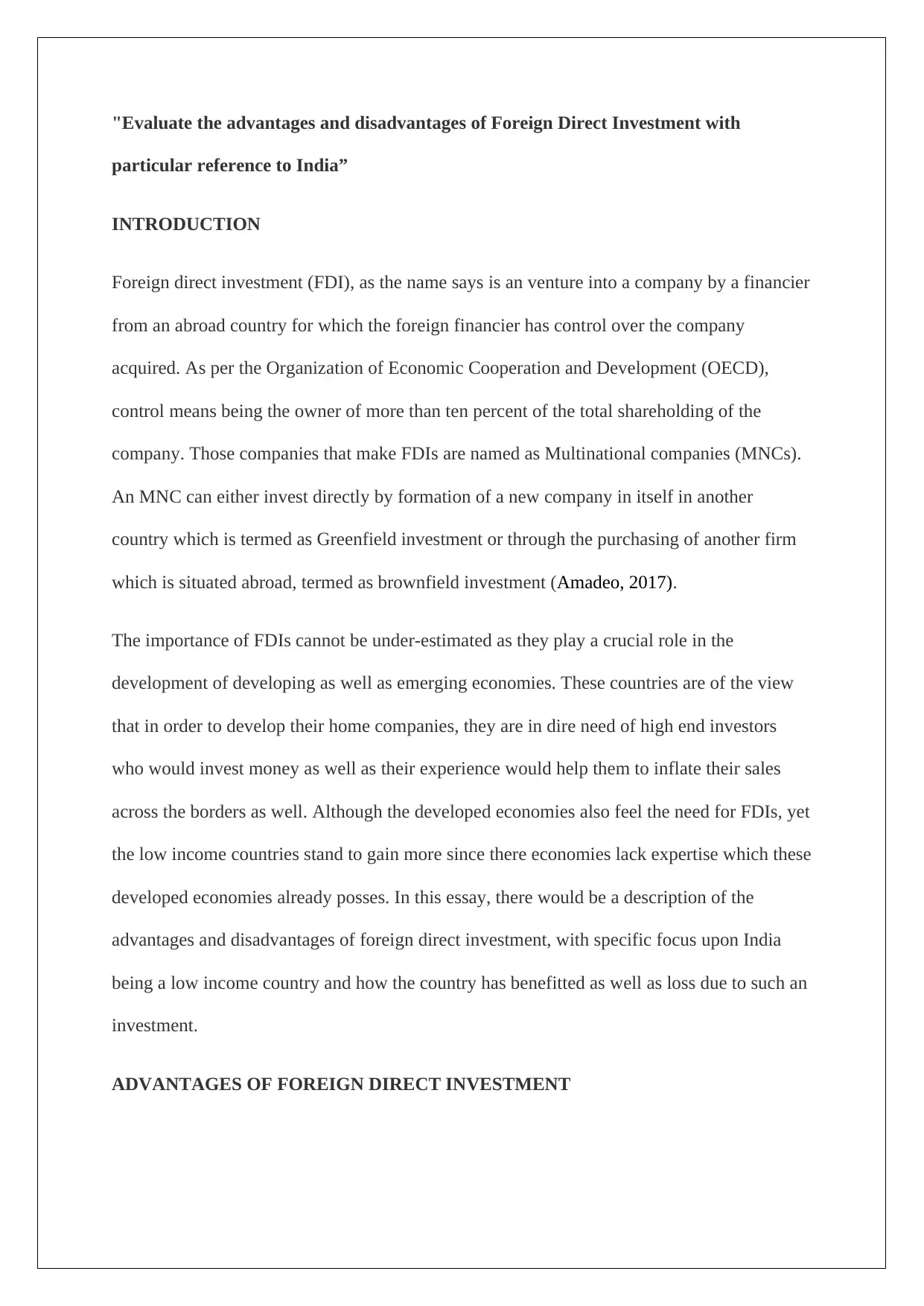
"Evaluate the advantages and disadvantages of Foreign Direct Investment with
particular reference to India”
INTRODUCTION
Foreign direct investment (FDI), as the name says is an venture into a company by a financier
from an abroad country for which the foreign financier has control over the company
acquired. As per the Organization of Economic Cooperation and Development (OECD),
control means being the owner of more than ten percent of the total shareholding of the
company. Those companies that make FDIs are named as Multinational companies (MNCs).
An MNC can either invest directly by formation of a new company in itself in another
country which is termed as Greenfield investment or through the purchasing of another firm
which is situated abroad, termed as brownfield investment (Amadeo, 2017).
The importance of FDIs cannot be under-estimated as they play a crucial role in the
development of developing as well as emerging economies. These countries are of the view
that in order to develop their home companies, they are in dire need of high end investors
who would invest money as well as their experience would help them to inflate their sales
across the borders as well. Although the developed economies also feel the need for FDIs, yet
the low income countries stand to gain more since there economies lack expertise which these
developed economies already posses. In this essay, there would be a description of the
advantages and disadvantages of foreign direct investment, with specific focus upon India
being a low income country and how the country has benefitted as well as loss due to such an
investment.
ADVANTAGES OF FOREIGN DIRECT INVESTMENT
particular reference to India”
INTRODUCTION
Foreign direct investment (FDI), as the name says is an venture into a company by a financier
from an abroad country for which the foreign financier has control over the company
acquired. As per the Organization of Economic Cooperation and Development (OECD),
control means being the owner of more than ten percent of the total shareholding of the
company. Those companies that make FDIs are named as Multinational companies (MNCs).
An MNC can either invest directly by formation of a new company in itself in another
country which is termed as Greenfield investment or through the purchasing of another firm
which is situated abroad, termed as brownfield investment (Amadeo, 2017).
The importance of FDIs cannot be under-estimated as they play a crucial role in the
development of developing as well as emerging economies. These countries are of the view
that in order to develop their home companies, they are in dire need of high end investors
who would invest money as well as their experience would help them to inflate their sales
across the borders as well. Although the developed economies also feel the need for FDIs, yet
the low income countries stand to gain more since there economies lack expertise which these
developed economies already posses. In this essay, there would be a description of the
advantages and disadvantages of foreign direct investment, with specific focus upon India
being a low income country and how the country has benefitted as well as loss due to such an
investment.
ADVANTAGES OF FOREIGN DIRECT INVESTMENT
Paraphrase This Document
Need a fresh take? Get an instant paraphrase of this document with our AI Paraphraser
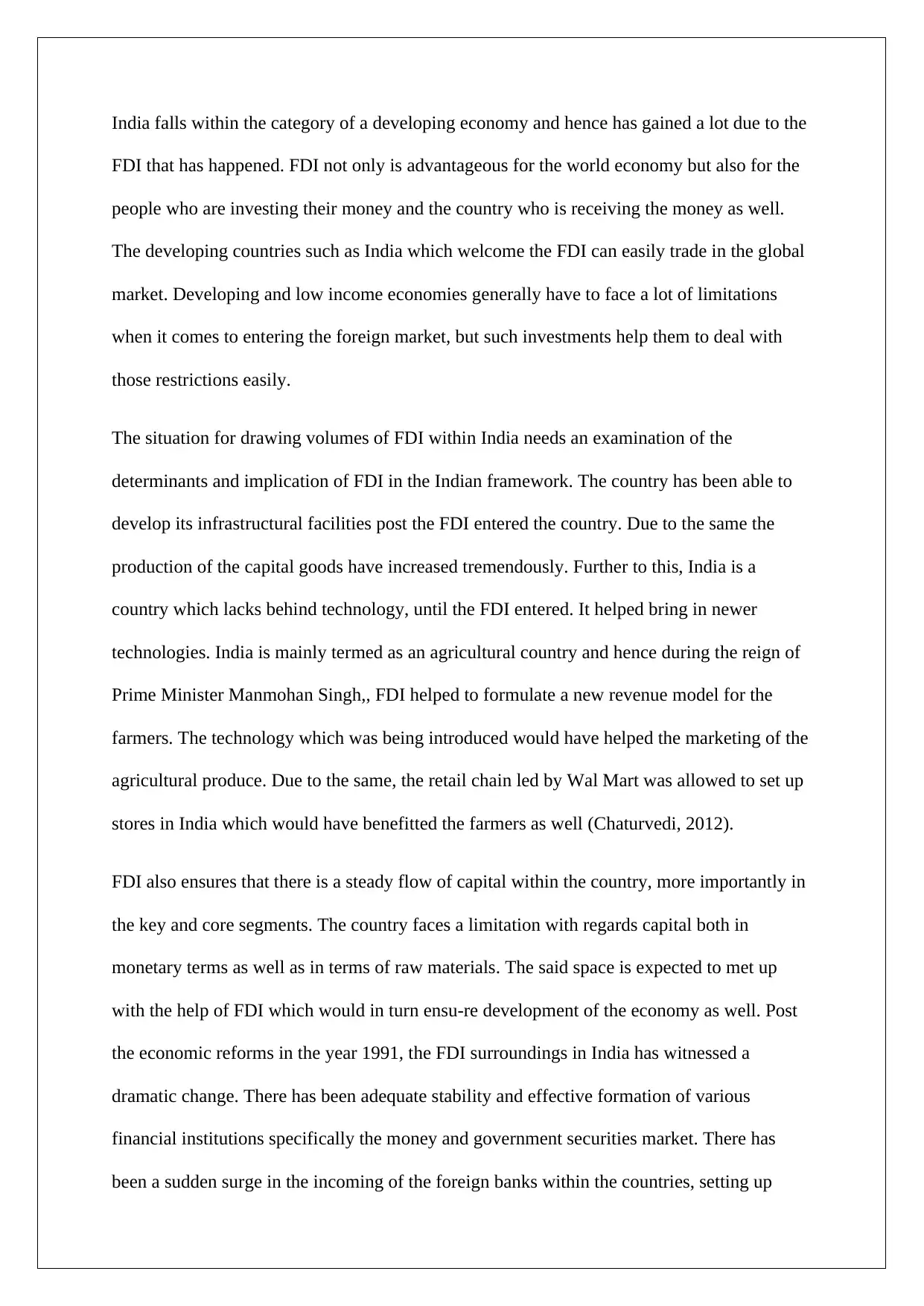
India falls within the category of a developing economy and hence has gained a lot due to the
FDI that has happened. FDI not only is advantageous for the world economy but also for the
people who are investing their money and the country who is receiving the money as well.
The developing countries such as India which welcome the FDI can easily trade in the global
market. Developing and low income economies generally have to face a lot of limitations
when it comes to entering the foreign market, but such investments help them to deal with
those restrictions easily.
The situation for drawing volumes of FDI within India needs an examination of the
determinants and implication of FDI in the Indian framework. The country has been able to
develop its infrastructural facilities post the FDI entered the country. Due to the same the
production of the capital goods have increased tremendously. Further to this, India is a
country which lacks behind technology, until the FDI entered. It helped bring in newer
technologies. India is mainly termed as an agricultural country and hence during the reign of
Prime Minister Manmohan Singh,, FDI helped to formulate a new revenue model for the
farmers. The technology which was being introduced would have helped the marketing of the
agricultural produce. Due to the same, the retail chain led by Wal Mart was allowed to set up
stores in India which would have benefitted the farmers as well (Chaturvedi, 2012).
FDI also ensures that there is a steady flow of capital within the country, more importantly in
the key and core segments. The country faces a limitation with regards capital both in
monetary terms as well as in terms of raw materials. The said space is expected to met up
with the help of FDI which would in turn ensu-re development of the economy as well. Post
the economic reforms in the year 1991, the FDI surroundings in India has witnessed a
dramatic change. There has been adequate stability and effective formation of various
financial institutions specifically the money and government securities market. There has
been a sudden surge in the incoming of the foreign banks within the countries, setting up
FDI that has happened. FDI not only is advantageous for the world economy but also for the
people who are investing their money and the country who is receiving the money as well.
The developing countries such as India which welcome the FDI can easily trade in the global
market. Developing and low income economies generally have to face a lot of limitations
when it comes to entering the foreign market, but such investments help them to deal with
those restrictions easily.
The situation for drawing volumes of FDI within India needs an examination of the
determinants and implication of FDI in the Indian framework. The country has been able to
develop its infrastructural facilities post the FDI entered the country. Due to the same the
production of the capital goods have increased tremendously. Further to this, India is a
country which lacks behind technology, until the FDI entered. It helped bring in newer
technologies. India is mainly termed as an agricultural country and hence during the reign of
Prime Minister Manmohan Singh,, FDI helped to formulate a new revenue model for the
farmers. The technology which was being introduced would have helped the marketing of the
agricultural produce. Due to the same, the retail chain led by Wal Mart was allowed to set up
stores in India which would have benefitted the farmers as well (Chaturvedi, 2012).
FDI also ensures that there is a steady flow of capital within the country, more importantly in
the key and core segments. The country faces a limitation with regards capital both in
monetary terms as well as in terms of raw materials. The said space is expected to met up
with the help of FDI which would in turn ensu-re development of the economy as well. Post
the economic reforms in the year 1991, the FDI surroundings in India has witnessed a
dramatic change. There has been adequate stability and effective formation of various
financial institutions specifically the money and government securities market. There has
been a sudden surge in the incoming of the foreign banks within the countries, setting up
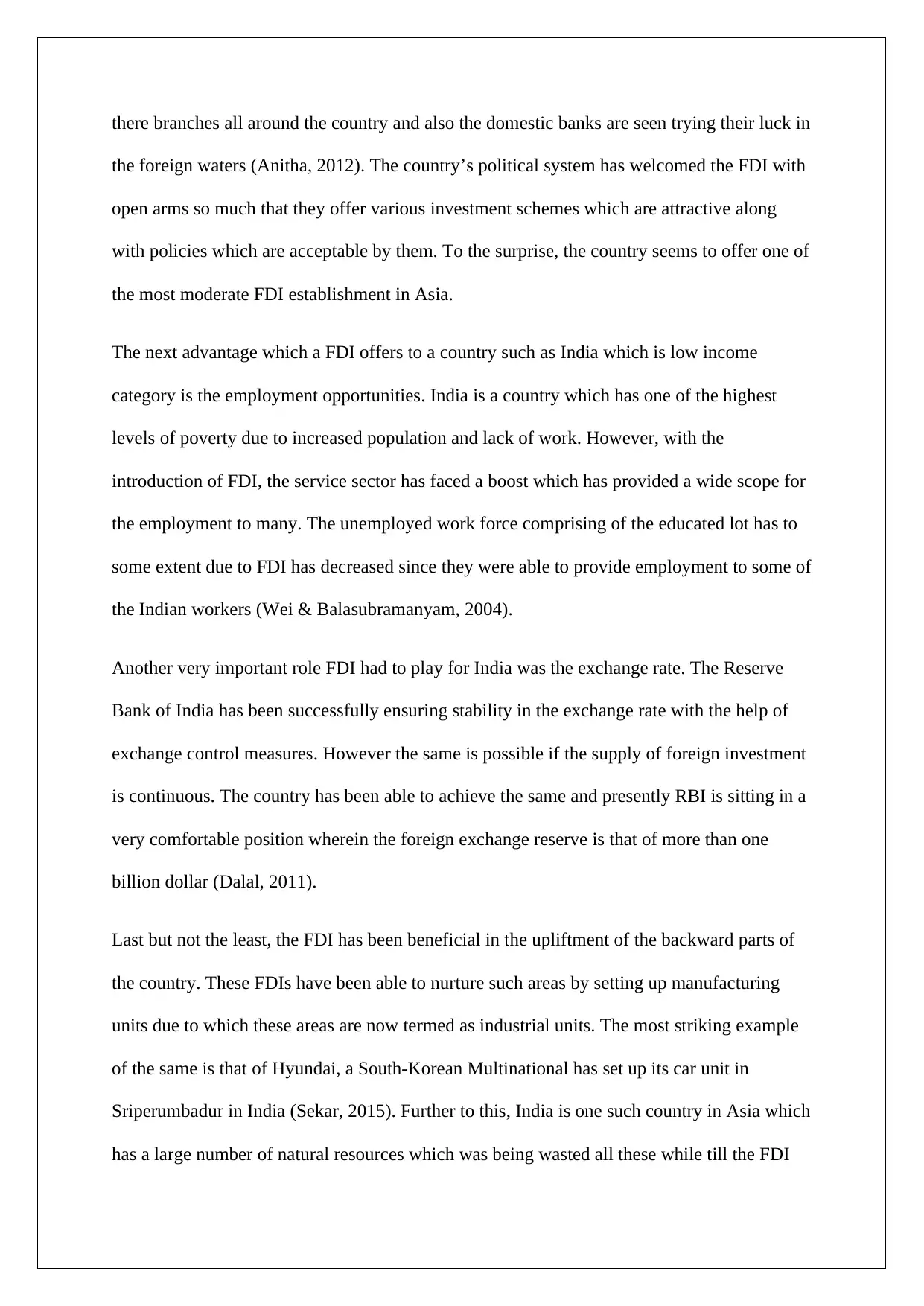
there branches all around the country and also the domestic banks are seen trying their luck in
the foreign waters (Anitha, 2012). The country’s political system has welcomed the FDI with
open arms so much that they offer various investment schemes which are attractive along
with policies which are acceptable by them. To the surprise, the country seems to offer one of
the most moderate FDI establishment in Asia.
The next advantage which a FDI offers to a country such as India which is low income
category is the employment opportunities. India is a country which has one of the highest
levels of poverty due to increased population and lack of work. However, with the
introduction of FDI, the service sector has faced a boost which has provided a wide scope for
the employment to many. The unemployed work force comprising of the educated lot has to
some extent due to FDI has decreased since they were able to provide employment to some of
the Indian workers (Wei & Balasubramanyam, 2004).
Another very important role FDI had to play for India was the exchange rate. The Reserve
Bank of India has been successfully ensuring stability in the exchange rate with the help of
exchange control measures. However the same is possible if the supply of foreign investment
is continuous. The country has been able to achieve the same and presently RBI is sitting in a
very comfortable position wherein the foreign exchange reserve is that of more than one
billion dollar (Dalal, 2011).
Last but not the least, the FDI has been beneficial in the upliftment of the backward parts of
the country. These FDIs have been able to nurture such areas by setting up manufacturing
units due to which these areas are now termed as industrial units. The most striking example
of the same is that of Hyundai, a South-Korean Multinational has set up its car unit in
Sriperumbadur in India (Sekar, 2015). Further to this, India is one such country in Asia which
has a large number of natural resources which was being wasted all these while till the FDI
the foreign waters (Anitha, 2012). The country’s political system has welcomed the FDI with
open arms so much that they offer various investment schemes which are attractive along
with policies which are acceptable by them. To the surprise, the country seems to offer one of
the most moderate FDI establishment in Asia.
The next advantage which a FDI offers to a country such as India which is low income
category is the employment opportunities. India is a country which has one of the highest
levels of poverty due to increased population and lack of work. However, with the
introduction of FDI, the service sector has faced a boost which has provided a wide scope for
the employment to many. The unemployed work force comprising of the educated lot has to
some extent due to FDI has decreased since they were able to provide employment to some of
the Indian workers (Wei & Balasubramanyam, 2004).
Another very important role FDI had to play for India was the exchange rate. The Reserve
Bank of India has been successfully ensuring stability in the exchange rate with the help of
exchange control measures. However the same is possible if the supply of foreign investment
is continuous. The country has been able to achieve the same and presently RBI is sitting in a
very comfortable position wherein the foreign exchange reserve is that of more than one
billion dollar (Dalal, 2011).
Last but not the least, the FDI has been beneficial in the upliftment of the backward parts of
the country. These FDIs have been able to nurture such areas by setting up manufacturing
units due to which these areas are now termed as industrial units. The most striking example
of the same is that of Hyundai, a South-Korean Multinational has set up its car unit in
Sriperumbadur in India (Sekar, 2015). Further to this, India is one such country in Asia which
has a large number of natural resources which was being wasted all these while till the FDI
⊘ This is a preview!⊘
Do you want full access?
Subscribe today to unlock all pages.

Trusted by 1+ million students worldwide
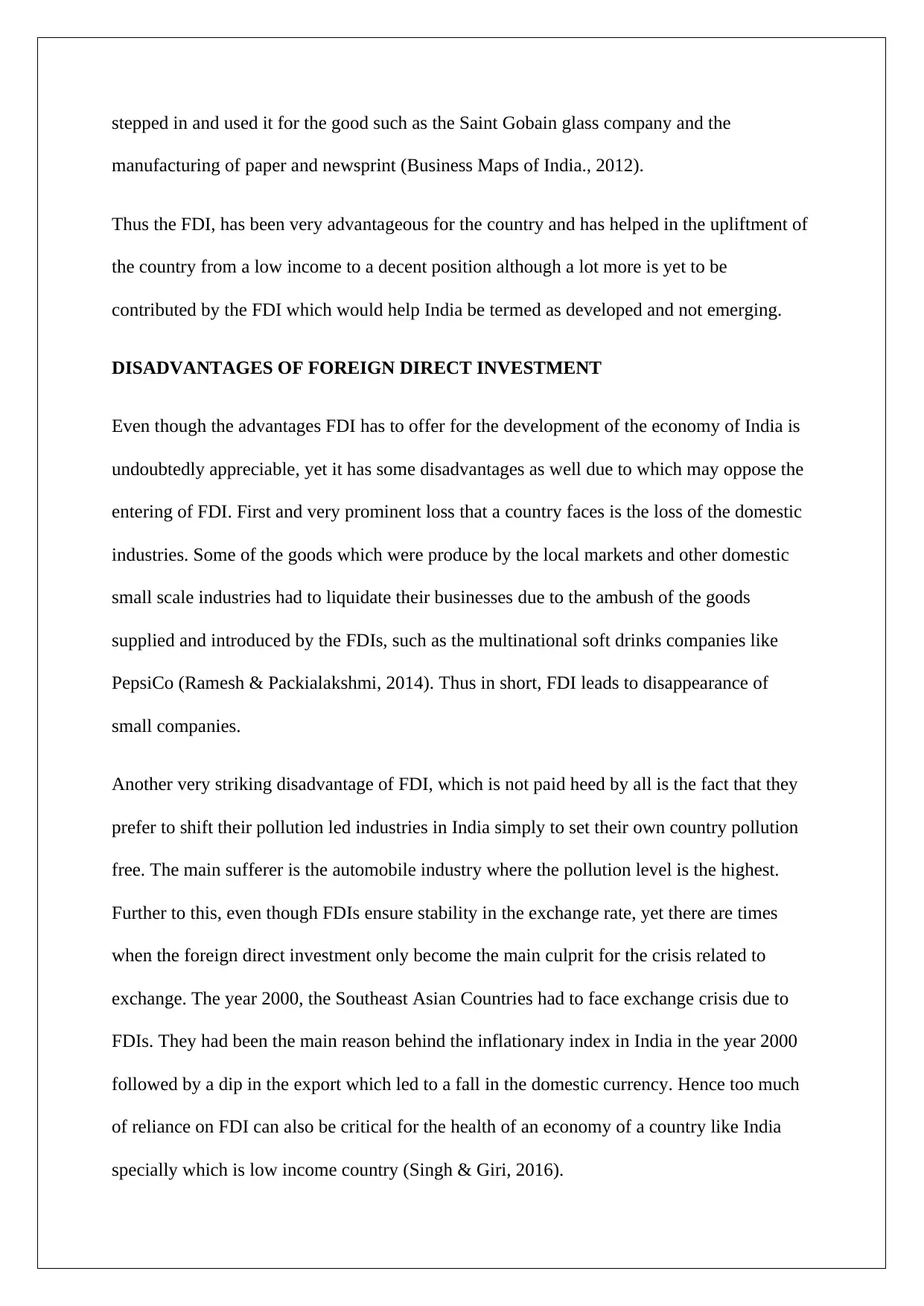
stepped in and used it for the good such as the Saint Gobain glass company and the
manufacturing of paper and newsprint (Business Maps of India., 2012).
Thus the FDI, has been very advantageous for the country and has helped in the upliftment of
the country from a low income to a decent position although a lot more is yet to be
contributed by the FDI which would help India be termed as developed and not emerging.
DISADVANTAGES OF FOREIGN DIRECT INVESTMENT
Even though the advantages FDI has to offer for the development of the economy of India is
undoubtedly appreciable, yet it has some disadvantages as well due to which may oppose the
entering of FDI. First and very prominent loss that a country faces is the loss of the domestic
industries. Some of the goods which were produce by the local markets and other domestic
small scale industries had to liquidate their businesses due to the ambush of the goods
supplied and introduced by the FDIs, such as the multinational soft drinks companies like
PepsiCo (Ramesh & Packialakshmi, 2014). Thus in short, FDI leads to disappearance of
small companies.
Another very striking disadvantage of FDI, which is not paid heed by all is the fact that they
prefer to shift their pollution led industries in India simply to set their own country pollution
free. The main sufferer is the automobile industry where the pollution level is the highest.
Further to this, even though FDIs ensure stability in the exchange rate, yet there are times
when the foreign direct investment only become the main culprit for the crisis related to
exchange. The year 2000, the Southeast Asian Countries had to face exchange crisis due to
FDIs. They had been the main reason behind the inflationary index in India in the year 2000
followed by a dip in the export which led to a fall in the domestic currency. Hence too much
of reliance on FDI can also be critical for the health of an economy of a country like India
specially which is low income country (Singh & Giri, 2016).
manufacturing of paper and newsprint (Business Maps of India., 2012).
Thus the FDI, has been very advantageous for the country and has helped in the upliftment of
the country from a low income to a decent position although a lot more is yet to be
contributed by the FDI which would help India be termed as developed and not emerging.
DISADVANTAGES OF FOREIGN DIRECT INVESTMENT
Even though the advantages FDI has to offer for the development of the economy of India is
undoubtedly appreciable, yet it has some disadvantages as well due to which may oppose the
entering of FDI. First and very prominent loss that a country faces is the loss of the domestic
industries. Some of the goods which were produce by the local markets and other domestic
small scale industries had to liquidate their businesses due to the ambush of the goods
supplied and introduced by the FDIs, such as the multinational soft drinks companies like
PepsiCo (Ramesh & Packialakshmi, 2014). Thus in short, FDI leads to disappearance of
small companies.
Another very striking disadvantage of FDI, which is not paid heed by all is the fact that they
prefer to shift their pollution led industries in India simply to set their own country pollution
free. The main sufferer is the automobile industry where the pollution level is the highest.
Further to this, even though FDIs ensure stability in the exchange rate, yet there are times
when the foreign direct investment only become the main culprit for the crisis related to
exchange. The year 2000, the Southeast Asian Countries had to face exchange crisis due to
FDIs. They had been the main reason behind the inflationary index in India in the year 2000
followed by a dip in the export which led to a fall in the domestic currency. Hence too much
of reliance on FDI can also be critical for the health of an economy of a country like India
specially which is low income country (Singh & Giri, 2016).
Paraphrase This Document
Need a fresh take? Get an instant paraphrase of this document with our AI Paraphraser
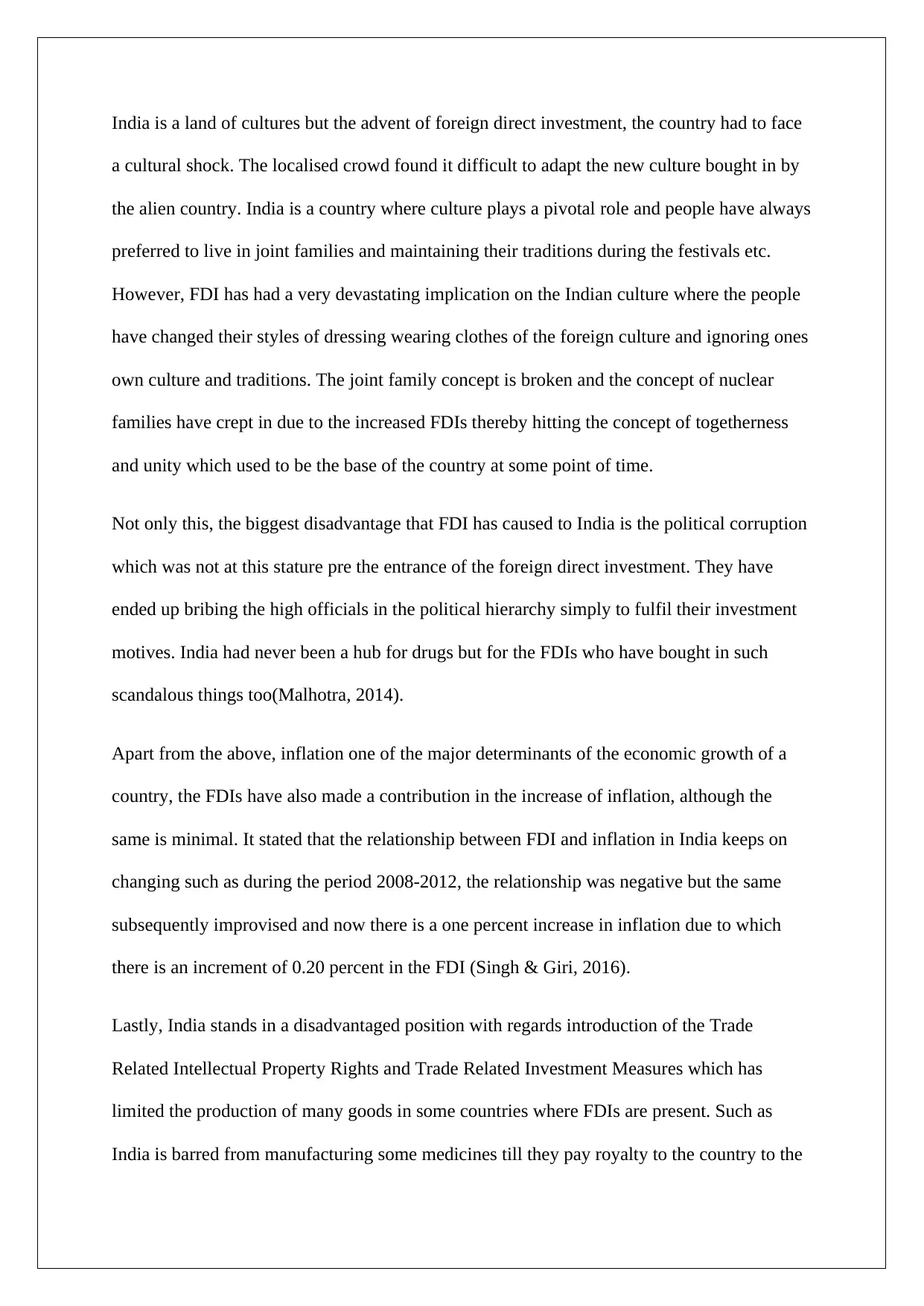
India is a land of cultures but the advent of foreign direct investment, the country had to face
a cultural shock. The localised crowd found it difficult to adapt the new culture bought in by
the alien country. India is a country where culture plays a pivotal role and people have always
preferred to live in joint families and maintaining their traditions during the festivals etc.
However, FDI has had a very devastating implication on the Indian culture where the people
have changed their styles of dressing wearing clothes of the foreign culture and ignoring ones
own culture and traditions. The joint family concept is broken and the concept of nuclear
families have crept in due to the increased FDIs thereby hitting the concept of togetherness
and unity which used to be the base of the country at some point of time.
Not only this, the biggest disadvantage that FDI has caused to India is the political corruption
which was not at this stature pre the entrance of the foreign direct investment. They have
ended up bribing the high officials in the political hierarchy simply to fulfil their investment
motives. India had never been a hub for drugs but for the FDIs who have bought in such
scandalous things too(Malhotra, 2014).
Apart from the above, inflation one of the major determinants of the economic growth of a
country, the FDIs have also made a contribution in the increase of inflation, although the
same is minimal. It stated that the relationship between FDI and inflation in India keeps on
changing such as during the period 2008-2012, the relationship was negative but the same
subsequently improvised and now there is a one percent increase in inflation due to which
there is an increment of 0.20 percent in the FDI (Singh & Giri, 2016).
Lastly, India stands in a disadvantaged position with regards introduction of the Trade
Related Intellectual Property Rights and Trade Related Investment Measures which has
limited the production of many goods in some countries where FDIs are present. Such as
India is barred from manufacturing some medicines till they pay royalty to the country to the
a cultural shock. The localised crowd found it difficult to adapt the new culture bought in by
the alien country. India is a country where culture plays a pivotal role and people have always
preferred to live in joint families and maintaining their traditions during the festivals etc.
However, FDI has had a very devastating implication on the Indian culture where the people
have changed their styles of dressing wearing clothes of the foreign culture and ignoring ones
own culture and traditions. The joint family concept is broken and the concept of nuclear
families have crept in due to the increased FDIs thereby hitting the concept of togetherness
and unity which used to be the base of the country at some point of time.
Not only this, the biggest disadvantage that FDI has caused to India is the political corruption
which was not at this stature pre the entrance of the foreign direct investment. They have
ended up bribing the high officials in the political hierarchy simply to fulfil their investment
motives. India had never been a hub for drugs but for the FDIs who have bought in such
scandalous things too(Malhotra, 2014).
Apart from the above, inflation one of the major determinants of the economic growth of a
country, the FDIs have also made a contribution in the increase of inflation, although the
same is minimal. It stated that the relationship between FDI and inflation in India keeps on
changing such as during the period 2008-2012, the relationship was negative but the same
subsequently improvised and now there is a one percent increase in inflation due to which
there is an increment of 0.20 percent in the FDI (Singh & Giri, 2016).
Lastly, India stands in a disadvantaged position with regards introduction of the Trade
Related Intellectual Property Rights and Trade Related Investment Measures which has
limited the production of many goods in some countries where FDIs are present. Such as
India is barred from manufacturing some medicines till they pay royalty to the country to the
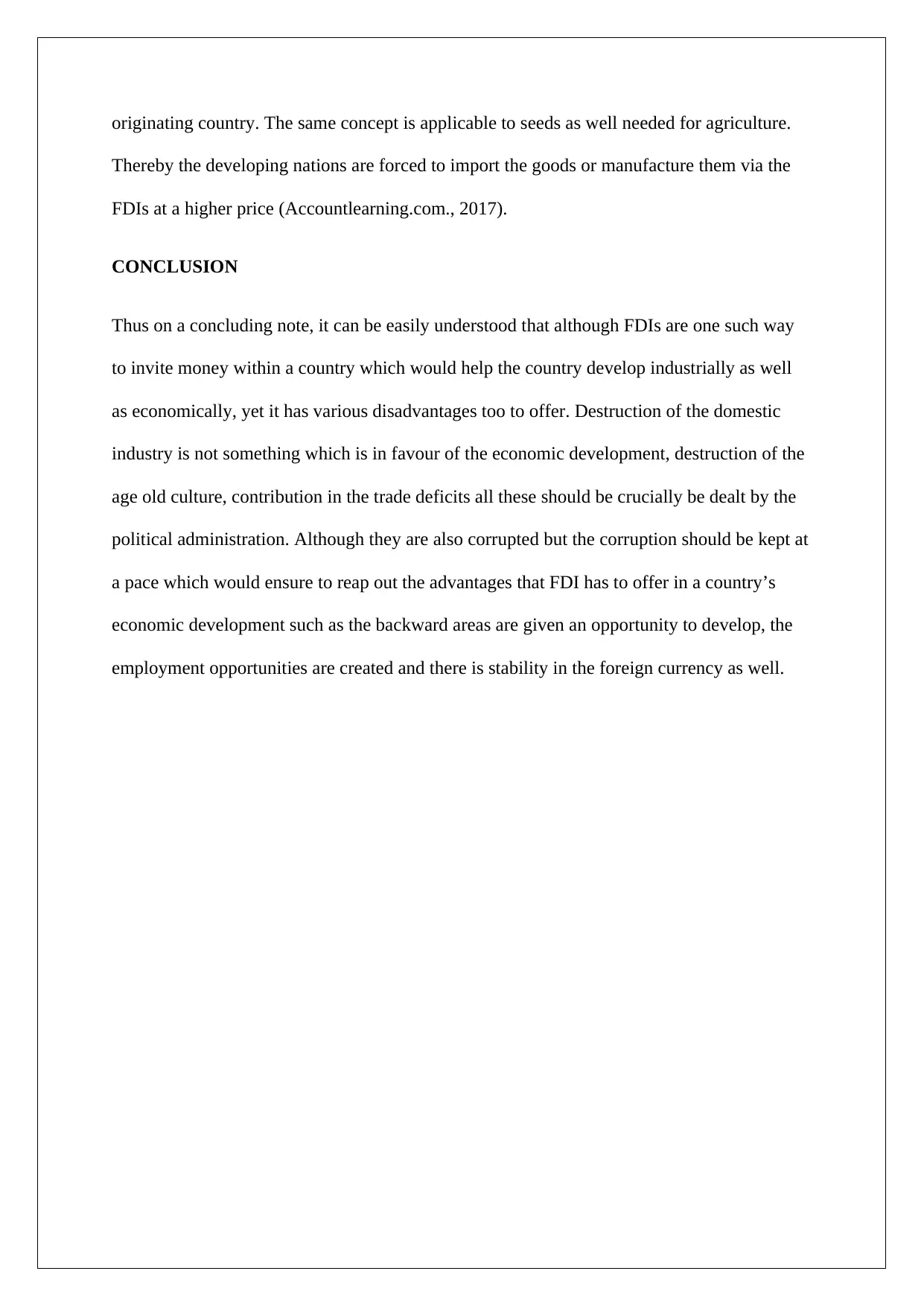
originating country. The same concept is applicable to seeds as well needed for agriculture.
Thereby the developing nations are forced to import the goods or manufacture them via the
FDIs at a higher price (Accountlearning.com., 2017).
CONCLUSION
Thus on a concluding note, it can be easily understood that although FDIs are one such way
to invite money within a country which would help the country develop industrially as well
as economically, yet it has various disadvantages too to offer. Destruction of the domestic
industry is not something which is in favour of the economic development, destruction of the
age old culture, contribution in the trade deficits all these should be crucially be dealt by the
political administration. Although they are also corrupted but the corruption should be kept at
a pace which would ensure to reap out the advantages that FDI has to offer in a country’s
economic development such as the backward areas are given an opportunity to develop, the
employment opportunities are created and there is stability in the foreign currency as well.
Thereby the developing nations are forced to import the goods or manufacture them via the
FDIs at a higher price (Accountlearning.com., 2017).
CONCLUSION
Thus on a concluding note, it can be easily understood that although FDIs are one such way
to invite money within a country which would help the country develop industrially as well
as economically, yet it has various disadvantages too to offer. Destruction of the domestic
industry is not something which is in favour of the economic development, destruction of the
age old culture, contribution in the trade deficits all these should be crucially be dealt by the
political administration. Although they are also corrupted but the corruption should be kept at
a pace which would ensure to reap out the advantages that FDI has to offer in a country’s
economic development such as the backward areas are given an opportunity to develop, the
employment opportunities are created and there is stability in the foreign currency as well.
⊘ This is a preview!⊘
Do you want full access?
Subscribe today to unlock all pages.

Trusted by 1+ million students worldwide
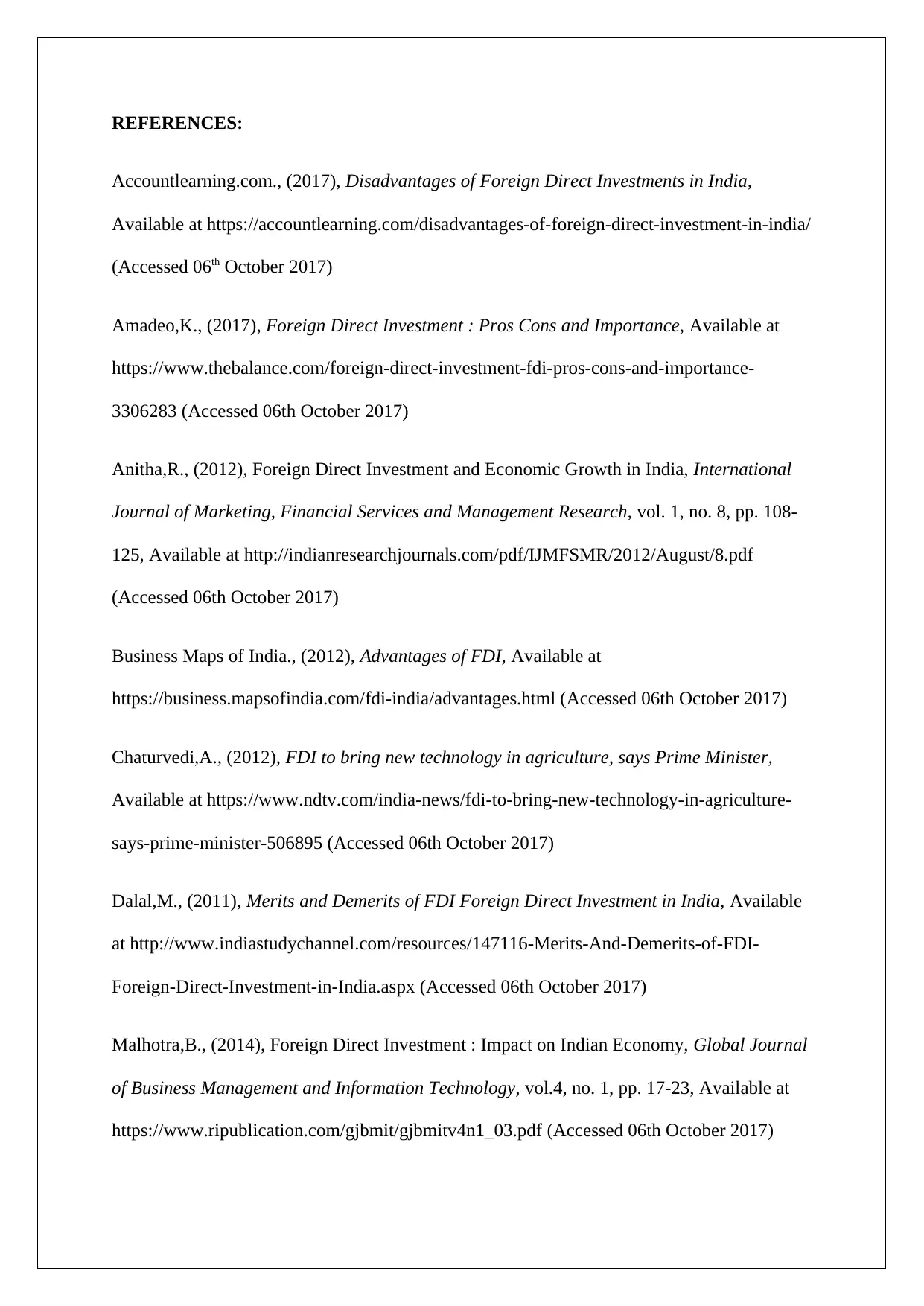
REFERENCES:
Accountlearning.com., (2017), Disadvantages of Foreign Direct Investments in India,
Available at https://accountlearning.com/disadvantages-of-foreign-direct-investment-in-india/
(Accessed 06th October 2017)
Amadeo,K., (2017), Foreign Direct Investment : Pros Cons and Importance, Available at
https://www.thebalance.com/foreign-direct-investment-fdi-pros-cons-and-importance-
3306283 (Accessed 06th October 2017)
Anitha,R., (2012), Foreign Direct Investment and Economic Growth in India, International
Journal of Marketing, Financial Services and Management Research, vol. 1, no. 8, pp. 108-
125, Available at http://indianresearchjournals.com/pdf/IJMFSMR/2012/August/8.pdf
(Accessed 06th October 2017)
Business Maps of India., (2012), Advantages of FDI, Available at
https://business.mapsofindia.com/fdi-india/advantages.html (Accessed 06th October 2017)
Chaturvedi,A., (2012), FDI to bring new technology in agriculture, says Prime Minister,
Available at https://www.ndtv.com/india-news/fdi-to-bring-new-technology-in-agriculture-
says-prime-minister-506895 (Accessed 06th October 2017)
Dalal,M., (2011), Merits and Demerits of FDI Foreign Direct Investment in India, Available
at http://www.indiastudychannel.com/resources/147116-Merits-And-Demerits-of-FDI-
Foreign-Direct-Investment-in-India.aspx (Accessed 06th October 2017)
Malhotra,B., (2014), Foreign Direct Investment : Impact on Indian Economy, Global Journal
of Business Management and Information Technology, vol.4, no. 1, pp. 17-23, Available at
https://www.ripublication.com/gjbmit/gjbmitv4n1_03.pdf (Accessed 06th October 2017)
Accountlearning.com., (2017), Disadvantages of Foreign Direct Investments in India,
Available at https://accountlearning.com/disadvantages-of-foreign-direct-investment-in-india/
(Accessed 06th October 2017)
Amadeo,K., (2017), Foreign Direct Investment : Pros Cons and Importance, Available at
https://www.thebalance.com/foreign-direct-investment-fdi-pros-cons-and-importance-
3306283 (Accessed 06th October 2017)
Anitha,R., (2012), Foreign Direct Investment and Economic Growth in India, International
Journal of Marketing, Financial Services and Management Research, vol. 1, no. 8, pp. 108-
125, Available at http://indianresearchjournals.com/pdf/IJMFSMR/2012/August/8.pdf
(Accessed 06th October 2017)
Business Maps of India., (2012), Advantages of FDI, Available at
https://business.mapsofindia.com/fdi-india/advantages.html (Accessed 06th October 2017)
Chaturvedi,A., (2012), FDI to bring new technology in agriculture, says Prime Minister,
Available at https://www.ndtv.com/india-news/fdi-to-bring-new-technology-in-agriculture-
says-prime-minister-506895 (Accessed 06th October 2017)
Dalal,M., (2011), Merits and Demerits of FDI Foreign Direct Investment in India, Available
at http://www.indiastudychannel.com/resources/147116-Merits-And-Demerits-of-FDI-
Foreign-Direct-Investment-in-India.aspx (Accessed 06th October 2017)
Malhotra,B., (2014), Foreign Direct Investment : Impact on Indian Economy, Global Journal
of Business Management and Information Technology, vol.4, no. 1, pp. 17-23, Available at
https://www.ripublication.com/gjbmit/gjbmitv4n1_03.pdf (Accessed 06th October 2017)
Paraphrase This Document
Need a fresh take? Get an instant paraphrase of this document with our AI Paraphraser
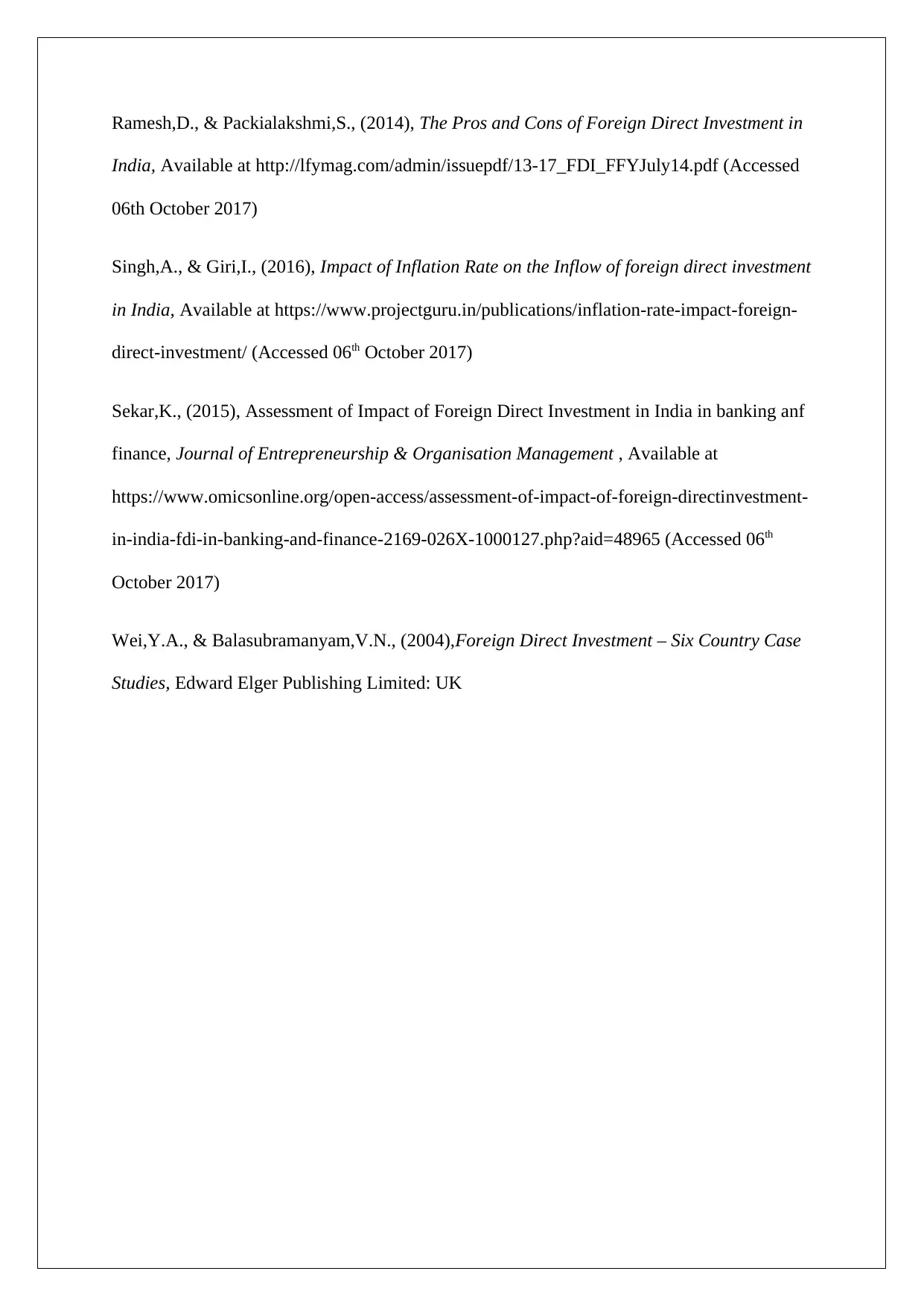
Ramesh,D., & Packialakshmi,S., (2014), The Pros and Cons of Foreign Direct Investment in
India, Available at http://lfymag.com/admin/issuepdf/13-17_FDI_FFYJuly14.pdf (Accessed
06th October 2017)
Singh,A., & Giri,I., (2016), Impact of Inflation Rate on the Inflow of foreign direct investment
in India, Available at https://www.projectguru.in/publications/inflation-rate-impact-foreign-
direct-investment/ (Accessed 06th October 2017)
Sekar,K., (2015), Assessment of Impact of Foreign Direct Investment in India in banking anf
finance, Journal of Entrepreneurship & Organisation Management , Available at
https://www.omicsonline.org/open-access/assessment-of-impact-of-foreign-directinvestment-
in-india-fdi-in-banking-and-finance-2169-026X-1000127.php?aid=48965 (Accessed 06th
October 2017)
Wei,Y.A., & Balasubramanyam,V.N., (2004),Foreign Direct Investment – Six Country Case
Studies, Edward Elger Publishing Limited: UK
India, Available at http://lfymag.com/admin/issuepdf/13-17_FDI_FFYJuly14.pdf (Accessed
06th October 2017)
Singh,A., & Giri,I., (2016), Impact of Inflation Rate on the Inflow of foreign direct investment
in India, Available at https://www.projectguru.in/publications/inflation-rate-impact-foreign-
direct-investment/ (Accessed 06th October 2017)
Sekar,K., (2015), Assessment of Impact of Foreign Direct Investment in India in banking anf
finance, Journal of Entrepreneurship & Organisation Management , Available at
https://www.omicsonline.org/open-access/assessment-of-impact-of-foreign-directinvestment-
in-india-fdi-in-banking-and-finance-2169-026X-1000127.php?aid=48965 (Accessed 06th
October 2017)
Wei,Y.A., & Balasubramanyam,V.N., (2004),Foreign Direct Investment – Six Country Case
Studies, Edward Elger Publishing Limited: UK
1 out of 8
Related Documents
Your All-in-One AI-Powered Toolkit for Academic Success.
+13062052269
info@desklib.com
Available 24*7 on WhatsApp / Email
![[object Object]](/_next/static/media/star-bottom.7253800d.svg)
Unlock your academic potential
Copyright © 2020–2025 A2Z Services. All Rights Reserved. Developed and managed by ZUCOL.





